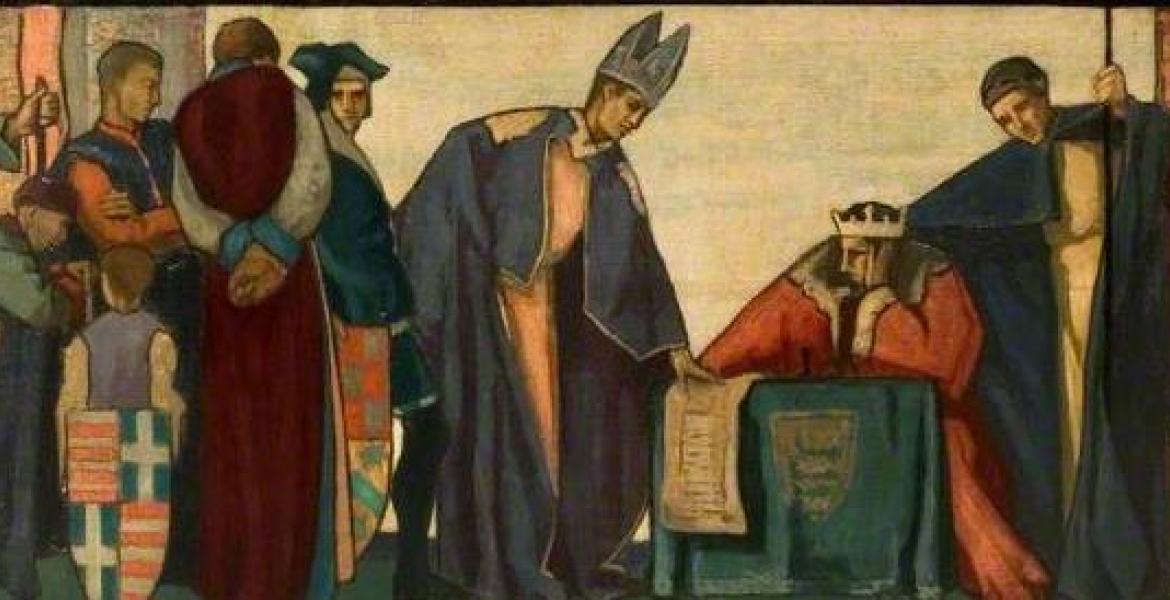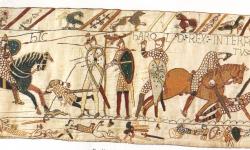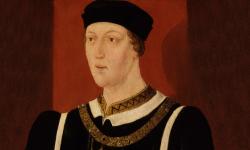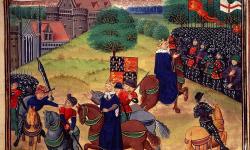Magna Carta
Key facts about Magna Carta
- Magna Carta was sealed at Runnymede by King John on 15 June 1215
- King John was forced to agree to it by rebellious barons
- It is said to be the basis for civil and human rights
- It focuses on the rights of the barons, rather than the common people
- It was annulledTo be declared invalid.To be declared invalid.To be declared invalid.To be declared invalid. after 10 weeks
People you need to know
- Henry I - a Norman king who ruled from 1100 until 1135.
- Henry III - son of King John and king from 1216 until 1272.
- Pope Innocent III - one of the most powerful and influential popes, he reigned from 1198 until 1216.
- King John - king from 1199 until 1216, he is generally considered a bad king.
Magna Carta (meaning 'Great Charter') is legendary as the foundation of modern human and civil rights, and of our current systems of government and law. Many look to its legend to give themselves authority legally or politically, and the last 33 British monarchs have sworn to uphold it. It is also said to have inspired the likes of the European Convention on Human Rights and the American ConstitutionA body of fundamental principles and established precedents by which a state governs itself; or the composition of something.. It has been discussed to such lengths that one judge and historian, Jonathan Sumption, said of it ‘It is impossible to say anything new about Magna Carta, unless you say something mad. In fact, even if you say something mad, the likelihood is that it will have been said before, probably quite recently.’ Lord Sumption, Magna Carta then and now: address to the Friends of the British Library, 9 March 2015, https://www.supremecourt.uk/docs/speech-150309.pdf In a recent court case, one Plymouth resident argued against an injunction by the council based on a clause in the Great Charter, while the former prime minister David Cameron referred to it as the document that paved the way for democracy, equality and the rule of law, the ‘foundation of all our laws and liberties’. It would not be too far a stretch to consider Magna Carta as one of the founding myths of England, but is there any substance to it?
Lord Sumption, Magna Carta then and now: address to the Friends of the British Library, 9 March 2015, https://www.supremecourt.uk/docs/speech-150309.pdf In a recent court case, one Plymouth resident argued against an injunction by the council based on a clause in the Great Charter, while the former prime minister David Cameron referred to it as the document that paved the way for democracy, equality and the rule of law, the ‘foundation of all our laws and liberties’. It would not be too far a stretch to consider Magna Carta as one of the founding myths of England, but is there any substance to it?
Magna Carta – or the ‘Article of the Barons’ as it was first known – was a result of the (mainly) northern barons' defiance against King John’s demands for money, his losses in war, and his absolute failure to abide by any code of chivalryA knightly code of correct social, religious and moral behaviour.A knightly code of correct social, religious and moral behaviour.A knightly code of correct social, religious and moral behaviour. and honour. In the years before 1215, John was unsuccessfully fighting to defend his French territories and paying for his wars with the possessions and estates of the barons, killing those who refused, and leaving women and children to starve, until those barons reached breaking point. They waged war on John, capturing London, before forcing him to submit to their demands in a field at Runnymede, which may - or may not - have been a place traditionally used for such negotiations. It is commonly believed that King John signed the document, but in fact he only put his seal to it. These demands became the 63 clauses of Magna Carta, and tackled all manner of complaints, from fish weirs in the Thames to the rights of free people to be given a fair trial. The most important clauses, 39 and 40, state that:
It is commonly believed that King John signed the document, but in fact he only put his seal to it. These demands became the 63 clauses of Magna Carta, and tackled all manner of complaints, from fish weirs in the Thames to the rights of free people to be given a fair trial. The most important clauses, 39 and 40, state that:
No free man is to be arrested, or imprisoned, or disseized, or outlawedDepriving someone of the protection of the law (so they can be hunted down and killed, for example), or banning/forbidding an object.Depriving someone of the protection of the law (so they can be hunted down and killed, for example), or banning/forbidding an object.Depriving someone of the protection of the law (so they can be hunted down and killed, for example), or banning/forbidding an object.Depriving someone of the protection of the law (so they can be hunted down and killed, for example), or banning/forbidding an object., or exiled, or in any other way ruined, nor will we go or send against him, except by the legal judgement of his peers or by the law of the land
and
To no one will we sell, to no one will we deny or delay, right or justice
Other clauses state that ‘There shall be one measure of wine in the whole of our realm, and one measure of ale, and one measure of corn’. They enshrined the freedom of the Church ‘in perpetuity’ and guaranteed the rights of the City of London. It is some of these points which have given Magna Carta the status it has today: clause 39 can still be found in the statute book.
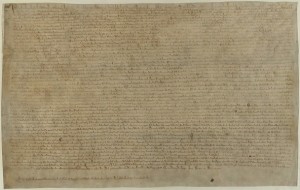
It is generally believed Magna Carta established a new constitutional framework, which for the first time placed the king under the law of the land. However, the notion that the monarchA king, queen, or emperorA king, queen, or emperorA king, queen, or emperorA king, queen, or emperor was answerable to the law was not a new one. Before Magna Carta, it was commonly acknowledged that the king was subject to the law, whether the law be from the Christian god or from tradition and custom. The pre-eminent political theorist in the twelfth century, John of Salisbury, showed that the difference between a king and a tyrantA cruel and oppressive ruler unrestrained by law or other people, although the early ancient Greeks used it to refer to anyone with absolute power.A cruel and oppressive ruler unrestrained by law or other people, although the early ancient Greeks used it to refer to anyone with absolute power. A cruel and oppressive ruler unrestrained by law or other people, although the early ancient Greeks used it to refer to anyone with absolute power. was willingness to abide by the law. Upon his accessionThe attainment or acquisition of a position of rank or power, often related to the throne.The attainment or acquisition of a position of rank or power, often related to the throne. to the throne in 1100, Henry I made an oath, which went down in history as his Charter of Liberties, that he would abide by the law and every monarch thereafter drew up similar documents, modelled on his. Not that Henry I abided by it. Henry had initially drawn it up to secure his position as king against the claims of his brother, Robert Curthose. Once he was assured of the crown, the Charter was largely ignored. The Charter of Liberties was even referred to during the negotiations for Magna Carta. The Article of the Barons was therefore more concerned with defining laws than with establishing whether or not the king should abide by them.
Not that Henry I abided by it. Henry had initially drawn it up to secure his position as king against the claims of his brother, Robert Curthose. Once he was assured of the crown, the Charter was largely ignored. The Charter of Liberties was even referred to during the negotiations for Magna Carta. The Article of the Barons was therefore more concerned with defining laws than with establishing whether or not the king should abide by them.
The laws proposed in the Great Charter were primarily concerned with feudalOf, or relating to, a Medieval social structure where, in theory, the nobility would protect everyone, the peasants would pay for this protection by working the land, and the clergy would pray for everyone. In the secular world, the monarch was at the top of the pyramid, with each layer of nobility and commons owing services or favour to the layers above and below them. Although the term relates to the Middle Ages, it was not actually coined until the 16th century, so some medievalists don't like it.Of, or relating to, a Medieval social structure where, in theory, the nobilityThe highest hereditary stratum of the aristocracy, sitting immediately below the monarch in terms of blood and title; or the quality of being noble (virtuous, honourable, etc.) in character. would protect everyone, the peasants would pay for this protection by working the land, and the clergyThe people ordained for religious duties, especially in the Christian Church. would pray for everyone. In the secularNot connected with religious matters. world, the monarch was at the top of the pyramid, with each layer of nobility…Of, or relating to, a Medieval social structure where, in theory, the nobilityThe highest hereditary stratum of the aristocracyA generic term for the highest social class., sitting immediately below the monarch in terms of blood and title; or the quality of being noble (virtuous, honourable, etc.) in character. would protect everyone, the peasants would pay for this protection by working the land, and the clergyThe people ordained for religious duties, especially in the Christian Church. would pray for everyone. In the secularNot connected with religious matters. world, the monarch was at the top of the pyramid, with each layer of nobility…Of, or relating to, a Medieval social structure where, in theory, the nobilityThe highest hereditary stratum of the aristocracyA generic term for the highest social class. , sitting immediately below the monarch in terms of blood and title; or the quality of being noble (virtuous, honourable, etc.) in character. would protect everyone, the peasants would pay for this protection by working the land, and the clergyThe people ordained for religious duties, especially in the Christian Church. would pray for everyone. In the secularNot connected with religious matters. world, the monarch was at the top of the pyramid, with each layer of nobility… rights and obligations rather than with the common man. Sumption says ‘It sought to enforce on the King conventions which were profoundly traditional, and obligations which he and his predecessorsPeople who held a job or office before the current incumbent.People who held a job or office before the current incumbent. People who held a job or office before the current incumbent. had acknowledged for more than a century. There are no high-flown declarations of principle.’ Sumption, Magna Carta then and now Those clauses generally considered to have provided the basis for modern human rights, such as the right to a trial by jury and habeas corpusThe right not to be imprisoned unlawfully.The right not to be imprisoned unlawfully.The right not to be imprisoned unlawfully.The right not to be imprisoned unlawfully. (the right not to be imprisoned unlawfully), were not relevant to criminal settings (where trials were usually done by ordeal or battle) but were attempts by the barons to limit the monarchyThe king/queen and royal family of a country, or a form of government with a king/queen at the head.The king/queen and royal family of a country, or a form of government with a king/queen at the head.The king/queen and royal family of a country, or a form of government with a king/queen at the head.The king/queen and royal family of a country, or a form of government with a king/queen at the head. from swiping their estates. Arrest on the monarch’s whim (and therefore against modern notions of habeas corpus) was still practised well into the seventeenth century.
Sumption, Magna Carta then and now Those clauses generally considered to have provided the basis for modern human rights, such as the right to a trial by jury and habeas corpusThe right not to be imprisoned unlawfully.The right not to be imprisoned unlawfully.The right not to be imprisoned unlawfully.The right not to be imprisoned unlawfully. (the right not to be imprisoned unlawfully), were not relevant to criminal settings (where trials were usually done by ordeal or battle) but were attempts by the barons to limit the monarchyThe king/queen and royal family of a country, or a form of government with a king/queen at the head.The king/queen and royal family of a country, or a form of government with a king/queen at the head.The king/queen and royal family of a country, or a form of government with a king/queen at the head.The king/queen and royal family of a country, or a form of government with a king/queen at the head. from swiping their estates. Arrest on the monarch’s whim (and therefore against modern notions of habeas corpus) was still practised well into the seventeenth century.
What was far more relevant to the vast majority of the king’s subjects was the Charter of the Forest, which was drawn up in 1217, and offered some economic protection to the peasantry as well as rolling back some of the common land rights lost to them following the Norman invasion. It was in this that the rights of the majority began to emerge, rather than in its earlier cousin, and it was only when they were joined in 1297 that Magna Carta began to be a charter for all. Furthermore, the original Magna Carta, sealed in 1215, was very unsuccessful. Not only did it rely on the threat of violence to protect peace, in the so-called 'security clause' (clause 61), but John also had it annulled by Pope Innocent III just 10 weeks later. The Pope called it ‘not only shameful and base but illegal and unjust’ and forbade John to adhere to it on pain of excommunicationA punishment for religious crimes, where the guilty person is not allowed to participate in any Church activities.A punishment for religious crimes, where the guilty person is not allowed to participate in any Church activities.A punishment for religious crimes, where the guilty person is not allowed to participate in any Church activities.A punishment for religious crimes, where the guilty person is not allowed to participate in any Church activities.. It was this renegingGoing back on a promise or contract.Going back on a promise or contract.Going back on a promise or contract.Going back on a promise or contract. on the agreement at Runnymede that led to the First Baron’s War. It was only when John died in 1216 that the rebel barons were brought back on side by the promise that John’s nine-year old heir, Henry III, would adhere to Magna Carta, and it was reissued with several clauses missing.
It was this reissue, prompted by the far-sighted regentSomeone who rules a state in the absence of the monarch, because the monarch is a child, absent or incapacitated.Someone who rules a state in the absence of the monarch, because the monarch is a child, absent or incapacitated.Someone who rules a state in the absence of the monarch, because the monarch is a child, absent or incapacitated., William Marshal, and papal legate, Guala of Bicchieri, that led to Magna Carta's place in the history books. The original charter was a non-entity, considered defunct by both parties, yet the new charter breathed new life into English politics. As Thomas Ashbridge says, 'It was not a mere peace treaty, extracted under duress from an embattled monarch, but a freely given assurance of rights.' Thomas Ashbridge, The Greatest Knight: The Remarkable Life of William Marshal, London: Simon & Schuster (2015), p.349 This, along with the papal approval that was so disastrously missing from the first document, immediately gave Magna Carta more longevity. And it was this longevity that allowed the 'momentously open-ended'
Thomas Ashbridge, The Greatest Knight: The Remarkable Life of William Marshal, London: Simon & Schuster (2015), p.349 This, along with the papal approval that was so disastrously missing from the first document, immediately gave Magna Carta more longevity. And it was this longevity that allowed the 'momentously open-ended' Tom Holland, 'Magna Carta was forged from royal failure' New Statesman 11 June 2015, accessed at http://www.newstatesman.com/politics/2015/06/tom-holland-magna-carta-wa… on 15 June 2017 rights of the first charter to become what they are today.
Tom Holland, 'Magna Carta was forged from royal failure' New Statesman 11 June 2015, accessed at http://www.newstatesman.com/politics/2015/06/tom-holland-magna-carta-wa… on 15 June 2017 rights of the first charter to become what they are today.
Things to think about
- How important is Magna Carta to our own laws and methods of governance?
- How successful was Magna Carta in the thirteenth century?
- Has Magna Carta ever been important?
- Why has Magna Carta got such as positive reputation?
- What can we learn about King John from the Magna Carta story?
Things to do
- Runnymede is a field with a memorial put up by the American Bar Association in 1957, and is owned by the National Trust. There isn't much to see or do, but it can make a pleasant walk and has become something of a site of pilgrimage. Find out more about visiting here.
- There are four copies of the original Magna Carta, and it is possible to see most of them. They are on display in the Treasures of the British Library exhibition at the British Library (information for which is here), at Salisbury Cathedral (find out information here), and usually it's also at Lincoln Cathedral (information here).
 The Lincoln Cathedral copy is currently on display in Lincoln Castle and will be back in the Cathedral in spring 2016.
The Lincoln Cathedral copy is currently on display in Lincoln Castle and will be back in the Cathedral in spring 2016. - The British Library also has an excellent online Magna Carta resource. You can find it here.
Further reading
There are a huge number of books available on Magna Carta and topics linked with it: An easy and cheap introduction is Nicholas Vincent's Magna Carta: A Very Short Introduction (part of the OUP Very Short Introductions series). A further light-hearted and chatty introduction is Dan Jones' Magna Carta: The Making and Legacy of the Great Charter. For information about King John, Marc Morris' book King John: Treachery, TyrannyCruel and oppressive rule or use of power.Cruel and oppressive rule or use of power.Cruel and oppressive rule or use of power.Cruel and oppressive rule or use of power. and the Road to Magna Carta is worth reading. For a wider social and political history of the age, try reading Danny Danziger's 1215: The Year of Magna Carta.
- Log in to post comments

